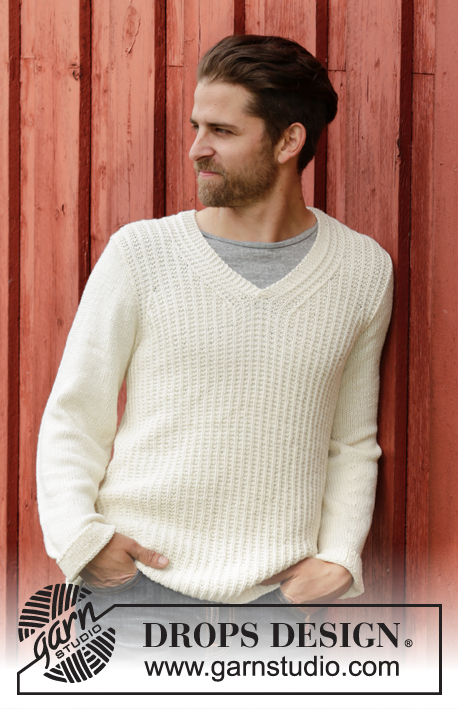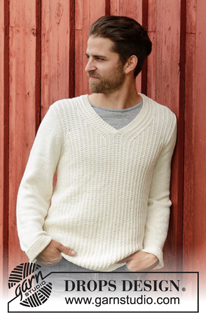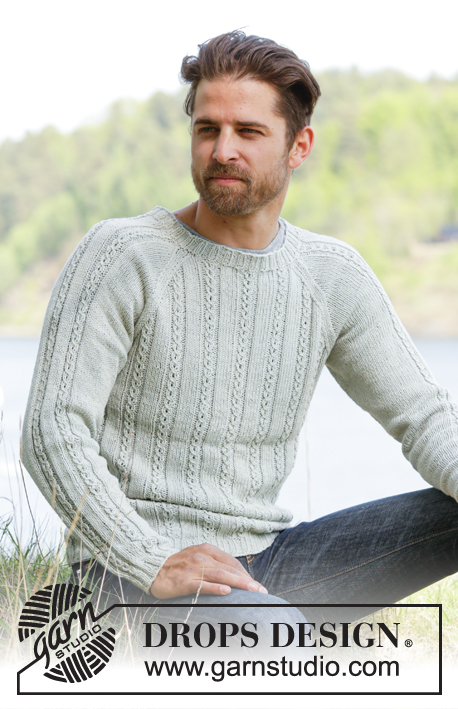Comments / Questions (68)
![]() Elaine Hébert wrote:
Elaine Hébert wrote:
Pour les manches de ce chandail J’aimerais prélever les mailles au niveau de l’emmanchure car je déteste les coutures. Combien de mailles devrais-je prélever et est-ce réalisable pour ce type d’emmanchure? La grandeur du chandail c’est large. Merci de me répondre!
03.02.2019 - 14:35DROPS Design answered:
Bonjour Mme Hébert, les manches de ce pull se tricotent ici de bas en haut, pas de haut en bas. Nous ne sommes malheureusement pas en mesure de pouvoir ajuster chacun de nos modèles à chaque demande, n'hésitez pas à demander de l'aide - même par mail ou téléphone - à votre magasin. Bon tricot!
04.02.2019 - 12:37
![]() Elaine Hébert wrote:
Elaine Hébert wrote:
La grandeur que j’ai choisi pour le corps c’est médium mais au niveau de la largeur des épaules c’est vraiment large qu’Il faut. Donc arriver à la séparation du dos et du devant puis-je me permettre de ne pas rabattre les 12 mailles pour les emmanchures (3 mailles de chaque côté du dos et du devant) puisque j’ai déjà 111 mailles pour le dos et le devant. Merci de m’aider !
29.01.2019 - 16:51DROPS Design answered:
Bonjour Mme Hébert, si vous ne rabattez pas les mailles des emmanchures, il ne faudra pas diminuer pour les manches non plus pour qu'elles restent droites, la forme du haut du pull et des manches s'en verra modifiée. Si votre tension est un peu juste en largeur, la taille L est peut être celle qui ira le mieux dès le début. Bon tricot!
30.01.2019 - 07:09
![]() Tom Erik wrote:
Tom Erik wrote:
Hei. Jeg liker også Lima svært godt og vurderer å bestille det til denne flotte modellen. Vil i så fall strukturmønsteret komme like godt frem? Har kun prøvd Lima til nordiske mønstre tidligere (fantastisk!)
03.01.2019 - 15:55DROPS Design answered:
Hei Tom Erik. Ja du kan gjerne strikke denne i Lima, strukturmønsteret vil komme godt frem. God fornøyelse
08.01.2019 - 11:16
![]() Elaine Hébert wrote:
Elaine Hébert wrote:
Si je prends 2 fils de Bébé Mérinos est-ce que je pourrai appliquer les instructions du patron?
21.12.2018 - 17:18DROPS Design answered:
Bonjour Mme Hébert, DROPS Baby Merino appartient au groupe A de nos fils, 2 fils du groupe A peuvent servir d'alternative à 1 fil du groupe C, mais DROPS Cotton Merino appartient au groupe B , BabyMerino ne peut pas être utilisé, même en double en alternative à un fil du groupe B - vous trouverez ici quelques infos complémentaires sur les alternatives. Bon tricot!
02.01.2019 - 08:38
![]() Monica wrote:
Monica wrote:
Tillægsinformation til mit tidligere stillede spørgsmål om hvordan jeg strikker kortere ærmer. Jeg bruger den næstmindste størrelse, altså hvor jeg slår 57 masker op på strømpepinde og skal i følge opskriften strikken ærmerne indtil de måler 64 cm. Jeg skal maksimalt have ærmer på 59-60 cm i længden. Mvh Monica
01.08.2018 - 11:53DROPS Design answered:
Hei Monica. Du kan øke hyppigere slik at ermet oppnår riktig vidde tidligere, og så kan du avpasse lengden deretter. Altså, du kan begynne å øke tidligere og så øke med kortere mellomrom mellom hver øking. Det letteste er nok å prøvde ermet på underveis så du ser hvordan det passer til din arm. God fornøyelse.
15.08.2018 - 07:58
![]() Monica wrote:
Monica wrote:
Jeg kan se at jeg kom til at lave slåfejl i mit just indsendt spørgsmål til jer. Sorry. Jeg ville høre om hvordan jeg kan korte i ærmelængden, da jeg har relativt korte arme, uden at ødelægge selve opskriften. På forhånd tak. Monica
01.08.2018 - 11:34
![]() Monica wrote:
Monica wrote:
Jeg er i gang med at strikke ovenstående herretrøje som er en dejlig strikkemodel, men jeg har relativt ret korte arme, hvordan kan jeg korte i lrmellmgden uden at jeg “ødelægger” opskriften? Vil sætte pris på svar fra jer. Bedste hilsner amonica
01.08.2018 - 11:31
![]() June Vogel wrote:
June Vogel wrote:
When you say "in the round" do you mean to connect (join) the yarn on the circular needle to truly knit in the round or do you leave an opening and just knit back and forth? If you connect the yarn, how do you make the right and wrong side when you do pattern A1?
25.07.2018 - 23:36DROPS Design answered:
Dear June, when the pattern say "on the round" it does mean truly on the round, so the round is joined, and the knitting goes around and around. The diagram shows every row of the the pattern from the right side, so when you knit, you read each row from felt to right. Happy Knitting
26.07.2018 - 01:15
![]() Marina wrote:
Marina wrote:
Je ne comprends pas le point. Est ce des côtes 2/1?
26.03.2018 - 15:04DROPS Design answered:
Bonjour Marina, tricotez A.1 en commençant en bas à droite et en lisant de droite à gauche tous les tours (puis tous les rangs sur l'endroit, sur l'envers, lisez de gauche à droite). Ainsi, quand on tricote le 2ème rang de A.1 sur l'endroit (= en rond), on a: *1 m env, 1 m end, 2 m env, 1 m end, 2 m env, 1 m end, 1 m env*, répétez de *-*. Et quand on tricote ce rang sur l'envers, on aura: *1 m end, 1 m env, 2 m end, 1 m env, 2 m end, 1 m env, 1 m end*, répétez de *-*. Bon tricot!
28.03.2018 - 14:29MARIA wrote:
Vielen Dank fuer die hilfe net von ihne so schnell zu antworten.
28.02.2018 - 10:17
Riley#rileysweater |
|||||||
 |
 |
||||||
Knitted men’s jumper with textured pattern and V-neck in DROPS Cotton Merino or DROPS Daisy. Size: S - XXXL.
DROPS 174-22 |
|||||||
|
GARTER ST (in the round on circular needle): * K 1 round and P 1 round *, repeat from *-*. 1 ridge = 2 rounds. PATTERN: See diagram A.1. DECREASE TIP ARMHOLE: Dec inside 7 sts in each side. Dec at beg of row as follows: Work 7 sts as before, slip 1 st as if to K, K next st, psso. Dec at end of row as follows: Work until 9 sts remain, K the next 2 tog, work the last 7 sts as before. DECREASE TIP NECK: All dec are done from RS. Dec inside 11 sts in each side. Dec as follows before band (left front piece). Work until 13 sts remain, K the next 2 tog, work the last 11 sts as before. Dec as follows after band (right front piece). Work 11 sts as before (= band st + 6 sts pattern), slip next st as if to K, K 1, psso. ---------------------------------------------------------- JUMPER: Worked in the round on circular needle. Cast on 198-222-234-258-282-306 sts on circular needle size 3.5 mm with Cotton Merino or DROPS Daisy. K 1 round, on next round work rib over all sts as follows: P 1, * K 1, P 2 *, repeat from *-* the entire round and finish with K 1 and P 1. Work rib for 4 cm. Switch to circular needle size 4 mm and work A.1 over all sts. When piece measures 45-46-47-48-49-50 cm, cast off for armholes in each side as follows: Cast off the first 3-3-3-6-6-6 sts, work 93-105-111-117-129-141 sts, cast off the next 6-6-6-12-12-12 sts, work 93-105-111-117-129-141 sts, cast off the last 3-3-3-6-6-6 sts. Finish front and back piece separately. BACK PIECE: = 93-105-111-117-129-141 sts. Continue with A.1 as before. AT THE SAME TIME on next row from RS continue dec for armholes in each side - dec 1 st in each side every other row 6-12-12-15-18-24 times in total – READ DECREASE TIP ARMHOLE! = 81-81-87-87-93-93 sts. When piece measures 62-64-66-68-70-72 cm, work in garter st over the middle 35-35-41-41-47-47 sts, continue the remaining sts in pattern. When piece measures 64-66-68-70-72-74 cm, cast off the middle 25-25-31-31-37-37 sts for neck = 28 sts remain on each shoulder in all sizes. Cast off when piece measures 66-68-70-72-74-76 cm. FRONT PIECE: = 93-105-111-117-129-141 sts. Insert a marker in the middle st. Continue to dec for armholes as on back piece. When piece measures 54-56-55-55-57-59 cm, keep sts until marker, st with marker and 2 sts after marker on needle, slip the remaining sts on a stitch holder. Now work in GARTER ST – see explanation above, over 5 sts towards mid front (= band), continue with A.1 over the remaining sts as before. Continue with dec for armhole, AT THE SAME TIME dec for neck as follows - READ DECREASE TIP NECK: Dec on every other row 15-15-18-18-21-21 times in total. After all dec for armhole and neck, 28 sts remain on shoulder in all sizes. Cast off when piece measures 66-68-70-72-74-76 cm. RIGHT FRONT PIECE: Slip sts from stitch holder back on needle and pick up 5 sts in garter st at the back of band on left front piece. Work as left front piece. SLEEVE: Worked in the round on double pointed needles. Cast on 54-57-60-60-63-66 sts on double pointed needles size 3.5 mm with Cotton Merino or DROPS Daisy. Insert 1 marker at the beg of round. K 1 round, then work rib = K 1/P 2. When piece measures 4 cm, switch to double pointed needle size 4 mm, continue with stocking st, on 1st round with stocking st dec 4-5-6-4-5-6 sts evenly = 50-52-54-56-58-60 sts on round. When piece measures 8 cm, inc 1 st on each side of marker. Inc every 4½-3-2½-2-2-1½ cm 8-11-12-18-20-22 times in total, then inc every 2 cm 5-5-5-0-0-0 times = 76-84-88-92-98-104 sts. When piece measures 54-53-53-51-51-50 cm (shorter measurements in the larger sizes because of longer sleeve cap and wider shoulders), cast off 6 sts mid under sleeve (= 3 sts on each side of marker) and work sleeve back and forth on circular needle until finished measurements. Cast off for sleeve cap at beg of every row in each side: Cast off 2 sts 5 times and 1 st 2-3-5-6-9-10 times, then cast off 2 sts in each side until piece measures 63-63-64-64-65-65 cm, then cast off 3 sts 1 time in each side. Cast off the remaining sts, piece measures approx. 64-64-65-65-66-66 cm. Knit another sleeve. ASSEMBLY: Sew the shoulder seams. Sew in sleeves. |
|||||||
Diagram explanations |
|||||||
|
|||||||
 |
|||||||
Have you finished this pattern?Tag your pictures with #dropspattern #rileysweater or submit them to the #dropsfan gallery. Do you need help with this pattern?You'll find 21 tutorial videos, a Comments/Questions area and more by visiting the pattern on garnstudio.com. © 1982-2025 DROPS Design A/S. We reserve all rights. This document, including all its sub-sections, has copyrights. Read more about what you can do with our patterns at the bottom of each pattern on our site. |
|||||||

























































Post a comment to pattern DROPS 174-22
We would love to hear what you have to say about this pattern!
If you want to leave a question, please make sure you select the correct category in the form below, to speed up the answering process. Required fields are marked *.